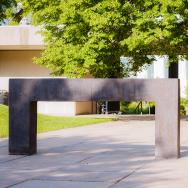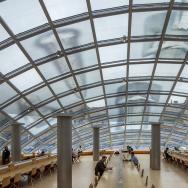Most students and faculty on the University of Chicago’s campus are familiar with Henry Moore’s famous sculpture, “Nuclear Energy,” which can be easily spotted on Ellis Avenue in front of Max Palevsky Residential Commons.
The twelve-foot bronze sculpture commemorates the first artificial self-sustaining nuclear chain reaction, built under the original location of the University’s Stagg Field in 1942 by a team of scientists led by Enrico Fermi. Commissioned by the University, the sculpture was unveiled twenty-five years after the event, on Dec. 2, 1967.
According to the UChicago Arts website, the sculpture serves as “both a celebration of [an] incredible human achievement, and also a warning against the dangers of harnessing such natural, physical power.”
A large number of artistic works (in the form of sculptures, murals, and more) can be found inside and outside of the University’s buildings, representing intellectual achievements across a wide variety of academic disciplines. But some of them, unlike “Nuclear Energy,” are often overlooked by passersby on a bustling campus.
“People think of the Smart Museum as the place where UChicago keeps the art, but the art is all around us,” said Laura Steward, UChicago’s curator of public art.
Whether they pay tribute to famous University events or popular artists, poets and thinkers who combined academics and creativity, these works of art merit a closer look.
On the quad
On the second-floor stairway landing of Harper Memorial Library, one passes by a large sculpted bust of 19th-century American poet Walt Whitman, famous for works like his self-published “Leaves of Grass” and his tribute to President Lincoln entitled “When Lilacs Last in the Dooryard Bloom’d.”
Completed in 1958, the sculpture was created by Simon Gordon, an artist known for working with the Works Progress Administration’s Illinois Art Project. After Gordon passed away, his wife donated the sculpture to the University in 1974. It was housed in Wieboldt Hall until the 1980s, when it was moved to Harper Memorial Library, where students, faculty, and visitors can view the sculpture today.
In a number of academic buildings, including Cobb Hall, the Classics Building, Stuart Hall, the Walker Museum, the Social Sciences Building, Harper Memorial Library, and more, passersby can view wall writings that comprise Helen Mirra’s piece, “Instance the Determination.” Installed in 2006, it was made with enamel paint by professional sign painters, guided by Mirra’s artistic vision.
The wall writings are index entries from “Experience and Nature” by John Dewey (1929) and “Newer Ideals of Peace” by Jane Addams (1907), both figures whose work was influential in Chicago.
Dewey taught at UChicago from 1894 to 1904 and worked towards education reform, and Addams was a social worker and feminist who founded the Hull House in 1889 in Chicago. The Hull House was a secular social settlement on Chicago’s Near West Side, and it provided a variety of services to its diverse population, including child care, libraries, and English and citizenship classes.
Both Dewey and Addams worked diligently in improving education and social services across the city, so it is no surprise that their work is commemorated in the University’s academic buildings.
Mirra was interested in the friendship between the two, and the comingling of their ideas. The locations of the piece are guided by Mirra’s ideas of aesthetics and architecture, their association with particular academic departments, and even her friendship with faculty members in particular buildings on the Quad.
As the piece was intended to be temporary, only about 18 remain on the walls of UChicago’s buildings. Whether they should be replaced or restored is up for debate, as entire walls have been removed, and departments have been relocated so the context of some of the entries has been lost.
“At this point, it’s about deciding how we should allow a piece of art to live in an environment that is constantly changing,” Steward said. “We need to work with the artist to create some kind of operating manual for the future.”
Historic murals
In Ida Noyes Hall, a building originally intended to be used as a women’s gymnasium and social center, the third floor theater space features “The Masque of Youth,” a 1918 mural by Chicago artist Jessie Arms Botke. Botke based the mural on an open-air masque at the 1916 dedication of Ida Noyes Hall itself.
Historically, masques have been spectacles performed for members of nobility involving music and choreographed dances by performers. These celebrations were popularized during the rule of King Henry VIII and continued to be performed frequently through the Elizabethan Era.
In 1916, around 300 students, alumni, and children participated in a similar outdoor performance, in which participants personified the city, lake and more. The mural intertwines traditional artistic symbols and figures, including Alma Mater, Knowledge and the Spirit of Worship, with depictions of campus buildings and the masque’s performers.
The mural is said to represent “the masque’s gentle hopefulness and its participants’ unquestioning belief in higher learning’s edifying powers.” After many years of accumulating a film of dirt from air pollution, the murals were restored in the 1990s and can be viewed and enjoyed today by all.
Science and art, intertwined
Ruth Duckworth’s “Earth, Water, Sky,” a four hundred-square-foot mural covers the four walls and ceiling of the entrance to the Henry Hinds Laboratory for Geophysical Sciences. The space is covered with over four hundred tiles with “fluid, biomorphic ceramic shapes.”
A former faculty member who taught at UChicago from 1964-1973, Duckworth is a sculptor who formerly worked at Midway Studios and was commissioned to create this work by Julian Goldsmith, chairman of the geophysical sciences department. The piece was commissioned at a particularly exciting time for the geophysical sciences, as the first satellite views of the earth were available, and earth science and atmospheric science were being joined together as one field.
Given Duckworth’s interest in studying satellite images and topographical maps, she created the mural as an abstract depiction of weather patterns, land topography, and rock formations. It includes “glass-filled craters, white cylindrical tubes encasing lights on the ceiling, swirling “fin-like” wedges, and the large cinder cone shape of Mt. Fuji composed of concentric circles.”
The artistic rendering of a variety of geophysical concepts demonstrates an adept combination of science and art, which is fittingly situated at the entrance of the University’s geophysical sciences building.
In the hustle and bustle of life on campus, it can be easy to miss some of these hidden gems, but UChicago’s interior artistic works demonstrate a commitment to appreciating art and beauty, and prove that art and other disciplines can go hand in hand.
Duckworth’s piece, for example, demonstrated that an inherently technical field like the geophysical sciences can be masterfully depicted and understood through art. These artistic works inspire intellectual curiosity towards the ways that art can collaborate with other fields to foster a continued desire to learn.
Steward, who is supported by the College Curricular Innovation Fund, provides support on a variety of projects to serve UChicago’s goal of involving students and faculty in artistic projects, such as the recent yearlong collective photography project, viewable on the Main Quad and across campus for much of the past school year, entitled “100 Views of Lake Michigan.”
Next year, she plans to create a new campus installation project entitled “Exemplary,” which she envisions as an artistic tribute to students in and recent alumni of the College who represent UChicago’s culture and “exemplify and amplify the glorious geekiness of us.” Steward also works with student interns who assist in the creative and administrative processes of these public art projects.
“Public art has a special way of speaking about what UChicago is,” Steward said. “It is an opportunity to reflect upon who we are as UChicago people and express particular aspects of our identity, inviting people to participate in and explore the intellectual and cultural life of the College.”
—This story was first published on the University of Chicago College website.

